Jet Propulsion Laboratory
After graduation Casani worked at the Rome Air Development Center in New York state. In 1956 he moved to Southern California, where he lived in his fraternity's house at the University of Southern California while looking for work. He was offered a position at North American Aviation working its Navaho missile project, but Jack James convinced him to join the Jet Propulsion Laboratory (JPL), where he worked on the guidance system for the Army Ballistic Missile Agency's Jupiter missile until the Sputnik crisis resulted in a change of priorities. [2]
From 1958 to 1959, Casani was a payload engineer working on Pioneer 3 and Pioneer 4. [3] These spacecraft were so small that he carried them in a suitcase to the University of Iowa to have their instruments calibrated. [2] He worked as a spacecraft systems engineer on Ranger 1 and Ranger 2 from 1959 to 1962, and then on the Mariner 3 and Mariner 4 Mars probes from 1962 to 1965. He became the Chief Engineer of the Mariner Mars project in 1965, Deputy Spacecraft System Manager in 1966, Spacecraft System Manager in 1969, and Project Manager in 1970. [3] Early missions to Mars were dogged by failures, which a reporter attributed to the Great Galactic Ghoul. [2] [4] After a hiatus, the Ghoul returned on Mariner 7, and Casani received drawing and paintings of the Ghoul. [2]
Casani served as project manager for the Voyager program from 1975 to 1977, and then the Galileo from 1977 to 1988. [3] This project was troubled by multiple delays and changes in configuration due to uncertainty as to how it should be launched on its way to Jupiter, and delays caused by the Space Shuttle Challenger disaster. It was finally launched by the Space Shuttle Atlantis in 1989, and reached Jupiter by a roundabout route in 1995. [5] It remained in orbit around Jupiter until 2003. [6] He became the Deputy Assistant Laboratory Director for Flight Projects in 1988, [7] and Assistant Laboratory Director for Flight Projects from in 1989. In 1994 he became Project Manager of the Cassini project. [3] He became Chief Engineer at JPL in 1994. [8]
Casani retired in 1999, but the retirement was a brief one; he was recalled two weeks later to work with the Johnson Space Center on a problem that could have caused the loss of the Shuttle Radar Topography Mission. He then headed up an internal JPL investigation of the loss of the Mars Climate Orbiter, Mars Polar Lander and Deep Space 2 probes, and was project manager for Project Prometheus until its termination in 2005. [2]

Galileo was an American robotic space program that studied the planet Jupiter and its moons, as well as several other Solar System bodies. Named after the Italian astronomer Galileo Galilei, the Galileo spacecraft consisted of an orbiter and an atmospheric entry probe. It was delivered into Earth orbit on October 18, 1989, by Space ShuttleAtlantis on the STS-34 mission, and arrived at Jupiter on December 7, 1995, after gravity assist flybys of Venus and Earth, and became the first spacecraft to orbit Jupiter. The spacecraft then launched the first probe to directly measure its atmosphere. Despite suffering major antenna problems, Galileo achieved the first asteroid flyby, of 951 Gaspra, and discovered the first asteroid moon, Dactyl, around 243 Ida. In 1994, Galileo observed Comet Shoemaker–Levy 9's collision with Jupiter.

Jet Propulsion Laboratory (JPL) is a federally funded research and development center in La Cañada Flintridge, California, Crescenta Valley, United States. Founded in 1936 by Caltech researchers, the laboratory is now owned and sponsored by the National Aeronautics and Space Administration (NASA) and administered and managed by the California Institute of Technology.

The Mariner program was conducted by the American space agency NASA to explore other planets. Between 1962 and late 1973, NASA's Jet Propulsion Laboratory (JPL) designed and built 10 robotic interplanetary probes named Mariner to explore the inner Solar System – visiting the planets Venus, Mars and Mercury for the first time, and returning to Venus and Mars for additional close observations.

Space exploration is the use of astronomy and space technology to explore outer space. While the exploration of space is currently carried out mainly by astronomers with telescopes, its physical exploration is conducted both by uncrewed robotic space probes and human spaceflight. Space exploration, like its classical form astronomy, is one of the main sources for space science.
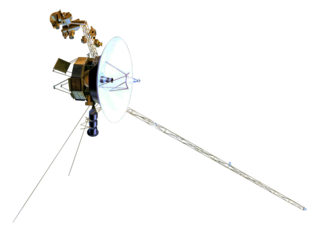
Voyager 1 is a space probe launched by NASA on September 5, 1977, as part of the Voyager program to study the outer Solar System and the interstellar space beyond the Sun's heliosphere. It was launched 16 days after its twin, Voyager 2. It communicates through the NASA Deep Space Network (DSN) to receive routine commands and to transmit data to Earth. Real-time distance and velocity data are provided by NASA and JPL. At a distance of 162.7 AU from Earth as of June 2024, it is the most distant human-made object from Earth. The probe made flybys of Jupiter, Saturn, and Saturn's largest moon, Titan. NASA had a choice of either doing a Pluto or Titan flyby; exploration of the moon took priority because it was known to have a substantial atmosphere. Voyager 1 studied the weather, magnetic fields, and rings of the two gas giants and was the first probe to provide detailed images of their moons.

The Voyager program is an American scientific program that employs two interstellar probes, Voyager 1 and Voyager 2. They were launched in 1977 to take advantage of a favorable alignment of the two gas giants Jupiter and Saturn and the ice giants, Uranus and Neptune, to fly near them while collecting data for transmission back to Earth. After launch, the decision was made to send Voyager 2 near Uranus and Neptune to collect data for transmission back to Earth.

A gravity assist, gravity assist maneuver, swing-by, or generally a gravitational slingshot in orbital mechanics, is a type of spaceflight flyby which makes use of the relative movement and gravity of a planet or other astronomical object to alter the path and speed of a spacecraft, typically to save propellant and reduce expense.

Pluto Kuiper Express was an interplanetary space probe that was proposed by Jet Propulsion Laboratory (JPL) scientists and engineers and under development by NASA. The spacecraft was intended to be launched to study Pluto and its moon Charon, along with one or more other Kuiper belt objects (KBOs). The proposal was the third of its kind, after the Pluto 350 and a proposal to send a Mariner Mark II spacecraft to Pluto.

Peter C. Theisinger is the director of the Engineering and Science Directorate at the Jet Propulsion Laboratory in Pasadena, California and was the project manager of NASA's Mars Exploration Rover Mission and later project manager for the 2011 Mars Science Laboratory mission.
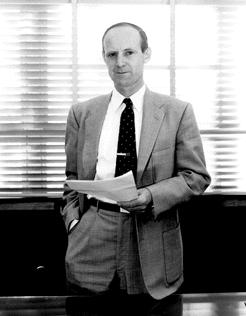
William Hayward Pickering was a New Zealand-born aerospace engineer who headed Pasadena, California's Jet Propulsion Laboratory (JPL) for 22 years, retiring in 1976. He was a senior NASA luminary and pioneered the exploration of space. Pickering was also a founding member of the United States National Academy of Engineering.

Mariner Mark II was NASA's planned family of uncrewed spacecraft for the exploration of the outer Solar System that were to be developed and operated by JPL between 1980 through the year 2010.

Raymond L. Heacock was an American engineer who spent his career at NASA's Jet Propulsion Laboratory where he worked on the Ranger program in the 1960s and on the Voyager program in the 1970s and 1980s. A Caltech engineering graduate, he was the winner of the James Watt International Medal for 1979.
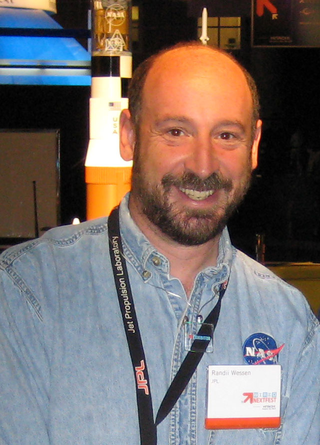
Randii Ray Wessen is an American astronautics systems engineer specifically involved in planetary exploration, experimental economist, and writer. Dr. Wessen has been an employee of the California Institute of Technology's Jet Propulsion Laboratory since 1984. He is currently the A-Team Lead Study Architect for JPL's Innovation Foundry. On the side, Wessen works with Dr. David Porter of Chapman University in the field of Experimental Economics, where they are designing a system to help allocate resources for building instruments on robotic deep space planetary spacecraft. This proposed system will build on the success of the Cassini Resource Exchange and be applied to NASA's Outer Planet Flagship Missions.
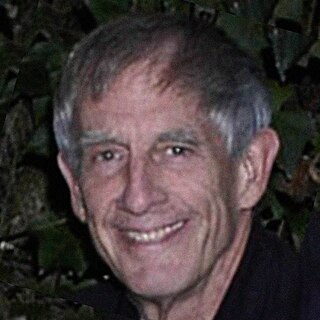
Charles Kohlhase worked for forty years at NASA/JPL leading the design of several robotic deep-space planetary missions. He is also an author, game developer and lecturer.

Jack Norval James was a US rocket engineer who worked for over 35 years at the Jet Propulsion Laboratory, Pasadena, California, USA. His work as a Project Manager for NASA's Mariner program in the 1960s included the first planetary flyby and first photographs by a space probe of Mars. He received commendations for his work from several US Presidents, and his awards include the NASA Exceptional Scientific Achievement Medal (1965) and the Stuart Ballantine Medal (1967).
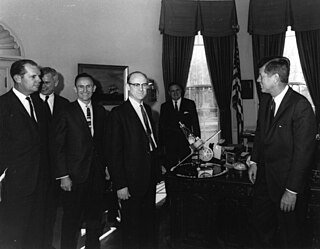
Robert J. "Bob" Parks was an American aerospace engineer and pioneer in the space program where he was intricately involved and/or directed for some of the most historic and important U.S. unmanned space missions. Over a 40-year tenure at the Jet Propulsion Laboratory (JPL/NASA), located in Pasadena, California, Parks’ impact was essential to helping the United States lead the world in space exploration. He served as Guidance Engineer for Explorer 1, the first successfully launched satellite by the United States. He directed the initial flyby missions to the Moon, the first soft landing on the Moon, Earth's first successful mission to another planet and initial missions to Mars, Saturn, Jupiter and Uranus.
Robert Samuel Kraemer was an American aerospace engineer who served as Director of Planetary Programs at the National Aeronautics and Space Administration from 1971 to 1976.

Shuttle-Centaur was a version of the Centaur upper stage rocket designed to be carried aloft inside the Space Shuttle and used to launch satellites into high Earth orbits or probes into deep space. Two variants were developed: Centaur G-Prime, which was planned to launch the Galileo and Ulysses robotic probes to Jupiter, and Centaur G, a shortened version planned for use with United States Department of Defense Milstar satellites and the Magellan Venus probe. The powerful Centaur upper stage allowed for heavier deep space probes, and for them to reach Jupiter sooner, prolonging the operational life of the spacecraft. However, neither variant ever flew on a Shuttle. Support for the project came from the United States Air Force (USAF) and the National Reconnaissance Office, which asserted that its classified satellites required the power of Centaur. The USAF agreed to pay half the design and development costs of Centaur G, and the National Aeronautics and Space Administration (NASA) paid the other half.

Galileo was an American robotic space probe that studied the planet Jupiter and its moons, as well as the asteroids Gaspra and Ida. Named after the Italian astronomer Galileo Galilei, it consisted of an orbiter and an entry probe. It was delivered into Earth orbit on October 18, 1989, by Space ShuttleAtlantis, during STS-34. Galileo arrived at Jupiter on December 7, 1995, after gravitational assist flybys of Venus and Earth, and became the first spacecraft to orbit an outer planet.

















